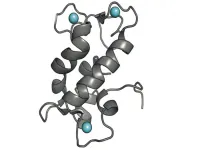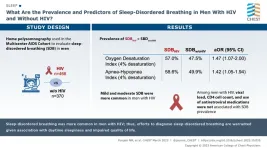(Press-News.org) Researchers have built the first ever map showing every single neuron and how they’re wired together in the brain of the fruit fly larva.
This huge step forwards in science will ultimately help us understand the basic principles by which signals travel through the brain at the neural level and lead to behaviour and learning.
The map of the 3016 neurons that make up the larva’s brain and the detailed circuitry of neural pathways within it is known as a ‘connectome’. It’s the largest complete brain connectome described yet.
Professor Marta Zlatic and Professor Albert Cardona of the Medical Research Council Laboratory of Molecular Biology and the University of Cambridge and colleagues from both the UK and the US led this ground-breaking research. The study is published in Science on 10 March 2023.
An organism's nervous system, including the brain, is made up of neurons which are connected to each other via synapses. Information in the form of chemicals passes from one neuron to another through these contact points.
Professor Zlatic said:
“The way the brain circuit is structured influences the computations the brain can do. But, up until this point, we’ve not seen the structure of any brain except of the roundworm C. elegans, the tadpole of a low chordate, and the larva of a marine annelid, all of which have several hundred neurons. This means neuroscience has been mostly operating without circuit maps. Without knowing the structure of a brain, we’re guessing on the way computations are implemented. But now, we can start gaining a mechanistic understanding of how the brain works.”
Zlatic explained that current technology isn’t yet advanced enough to map the connectome for higher animals such as large mammals. However, she said:
“All brains are similar – they are all networks of interconnected neurons – and all brains of all species have to perform many complex behaviours: they all need to process sensory information, learn, select actions, navigate their environments, choose food, recognise their conspecifics, escape from predators etc. In the same way that genes are conserved across the animal kingdom, I think that the basic circuit motifs that implement these fundamental behaviours will also be conserved.”
To build a picture of the fruit fly larva connectome, Zlatic, Cardona and colleagues scanned thousands of slices of the larva’s brain using a high-resolution electron microscope. They reconstructed the resulting images into a map of the fly’s brain and painstakingly annotated the connections between neurons. As well as mapping the 3016 neurons, they mapped an incredible 548,000 synapses.
The researchers also developed computational tools to identify likely pathways of information flow and different types of circuit motifs in the insect’s brain They also found that some of the structural features are exactly like state-of-the-art deep learning architecture.
Zlatic said:
“The most challenging aspect of this work was understanding and interpreting what we saw. We were faced with a complex neural circuit with lots of structure. In collaboration with Professor Priebe and Professor Vogestein’s groups at Johns Hopkins University, we developed computational tools to extract and predict from the structure the relevant circuit motives. By comparing this biological system, we can potentially also inspire better artificial networks.”
Jo Latimer, Head of Neurosciences and Mental Health at the Medical Research Council, said:
“This is an exciting and significant body of work by colleagues at the MRC Laboratory of Molecular Biology and others. Not only have they mapped every single neuron in the insect’s brain, but they’ve also worked out how each neuron is connected. This is a big step forward in addressing key questions about how the brain works, particularly how signals move through the neurons and synapses leading to behaviour, and this detailed understanding may lead to therapeutic interventions in the future.”
The next step will be to delve deeper to understand, for example, the architecture required for specific behavioural functions, such as learning and decision making, and look at activity in the whole connectome while the insect is doing things.
ENDS
END
First wiring map of neurons in insect brain complete
Researchers have built the first ever map showing every single neuron and how they’re wired together in the brain of the fruit fly larva
2023-03-09
ELSE PRESS RELEASES FROM THIS DATE:
Large-scale study enables new insights into rare eye disorders
2023-03-09
Researchers have analysed image and genomic data from the UK Biobank to find insights into rare diseases of the human eye. These include retinal dystrophies – a group of inherited disorders affecting the retina – which are also the leading cause of blindness certification in working-age adults.
The retina is found at the back of the eye. It’s a layered tissue that receives light and converts it into a signal that can be interpreted by the brain. Each retinal layer comprises different cell types that play a unique role in this light conversion process.
For this study published in the journal PLOS Genetics, the researchers focused ...
University of Ottawa's Dr. Natasha Kekre wins national recognition for early career success in healthcare research
2023-03-09
Dr. Natasha Kekre is this year’s national winner of a “young investigator award” from the Canadian Society for Clinical Investigation (north_eastexternal linkCSCI), an organization that represents early career healthcare researchers across the country.
An exceptionally motivated scientist, Dr. Kekre is an associate professor at the uOttawa Faculty of Medicine, as well as a scientist and hematologist at The Ottawa Hospital.
Dr. Kekre says she’s been “very fortunate” to be in Ottawa’s dynamic medical research hub and benefit from having internationally ...
Nirogacestat, a new desmoid tumor treatment, improves outcomes for people with sarcoma
2023-03-09
A phase 3 clinical trial (research study) of a targeted therapy called nirogacestat has found that the drug significantly shrank desmoid tumors in 41% of patients.
Desmoid tumors (also known as aggressive fibromatosis) are a rare type of soft tissue tumor, and MSK has a team of doctors who are dedicated to treating them.
When Dana Avellino, now 36, first noticed a lump near her groin in the summer of 2018, she thought it was related her recent cesarean section. Her younger daughter was only 2 months old at the time. When a biopsy revealed that the lump was a sarcoma, a type of tumor that ...
Ringing an electronic wave: Elusive massive phason observed in a charge density wave
2023-03-09
Researchers at the University of Illinois Urbana-Champaign have detected the existence of a charge density wave of electrons that acquires mass as it interacts with the background lattice ions of the material over long distances.
This new research, led by assistant professor Fahad Mahmood (Physics, Materials Research Laboratory) and postdoc Soyeun Kim (current postdoc at Stanford Institute for Materials and Energy Sciences, SLAC National Accelerator Laboratory), is a direct measurement of the Anderson-Higgs mechanism (of mass acquisition) and the first known demonstration of a massive phason in a charge ...
MSK Research Highlights, March 9, 2023
2023-03-09
New research from Memorial Sloan Kettering Cancer Center (MSK) and the Sloan Kettering Institute — a hub for basic science and translational research within MSK — offers new proof-of-concept compounds against acute myeloid leukemia; reports results from a phase 1 clinical trial appraising two drugs against low-grade glioma; examines MSK’s first-in-the-nation program integrating herbal medicine into oncology care; and identifies how high-grade histologic patterns ...
New biosensor reveals activity of elusive metal that’s essential for life
2023-03-09
UNIVERSITY PARK, Pa. — A new biosensor engineered by Penn State researchers offers scientists the first dynamic glimpses of manganese, an elusive metal ion that is essential for life.
The researchers engineered the sensor from a natural protein called lanmodulin, which binds rare earth elements with high selectivity and was discovered 5 years ago by some of the Penn State researchers involved in the present study.
They were able to genetically reprogram the protein to favor manganese over other common transition ...
Deconstructing Lignin
2023-03-09
It’s a tough job, but someone’s got to do it. In this case, the “job” is the breakdown of lignin, the structural biopolymer that gives stems, bark and branches their signature woodiness. One of the most abundant terrestrial polymers on Earth, lignin surrounds valuable plant fibers and other molecules that could be converted into biofuels and other commodity chemicals — if we could only get past that rigid plant cell wall.
Fortunately, the rather laborious process already occurs in the guts of large herbivores through the actions of anaerobic microbes that cows, goats and sheep rely on to release the nutrients ...
People don’t know what a preprint is. Here’s why that matters
2023-03-09
New research from the University of Georgia suggests most people don’t understand the difference between a preprint and a published academic journal article.
Preprints are research papers that haven’t undergone peer review, the process by which studies’ findings are validated by experts who weren’t involved with the research themselves.
The study found the majority of readers have little to no understanding of what a preprint actually is. That lack of understanding could lead to public distrust in science since findings and how those findings are described can change between the preprint phase and ...
Ontario sees big jump in amphetamine-related emergency visits
2023-03-09
Ontario’s emergency departments are seeing a dramatic rise in visits related to the use of unregulated amphetamines and their street equivalent: crystal meth.
In a new paper published in the Canadian Journal of Psychiatry, researchers found that individuals accessing the emergency department (ED) for amphetamine- and methamphetamine-related concerns grew from 233 in 2003 to 4,146 individuals annually by 2020.
“That’s a nearly 15-fold increase – pretty dramatic. If we consider ED visits as a crude proxy for how prevalent unregulated amphetamine use is, then the observed trend is highly concerning,” said the paper’s lead author, ...
Highlights from the journal CHEST®, March 2023
2023-03-09
Glenview, Illinois – Published monthly, the journal CHEST® features peer-reviewed, cutting-edge original research in chest medicine: Pulmonary, critical care and sleep medicine and related disciplines. Journal topics include asthma, chest infections, COPD, critical care, diffuse lung disease, education and clinical practice, pulmonary vascular disease, sleep, thoracic oncology and the humanities.
The March issue of the CHEST journal contains 44 articles, including clinically relevant research, reviews, case series, commentary and more. Each month, the journal also offers complementary ...
LAST 30 PRESS RELEASES:
Multichannel 3D-printed bioactive scaffold combined with siRNA delivery for spinal cord injury recovery
Triaptosis—an emerging paradigm in cancer therapeutics
A new paradigm in spectroscopic sensing: The revolutionary leap of SERS-optical waveguide integration and ai-enabled ultra-sensitive detection
Sweet tooth: How blood sugar migration in diabetes affects cavity development
Lowest suicide rate is in December but some in media still promote holiday-suicide myth
Record-breaking cosmic explosion challenges astronomers’ understanding of gamma-ray bursts
Excessive heat harms young children’s development, study suggests
Quanta Books to publish popular math and physics titles by Terence Tao and David Tong
Philanthropic partnerships fund next-generation instruments for mid-sized telescopes
AI offers ‘roadmap’ to plant genetics
Myosin XI-1: A key molecular target for salt-tolerant crops
Pusan National University study highlights the health hazards of ultrafine particles from small home appliances with electric heating coils and brushed DC motors
Global first: New Indigenous-led research initiative to revitalize legal orders
Transforming acoustic waves with a chip
When climate risk hits home, people listen: Study reveals key to engagement with disaster preparedness messaging
Major breakthrough against diabetes thanks to a microbial molecule that disarms inflammation
Silicon chips on the brain: Researchers announce a new generation of brain-computer interface
Getting rest is the best
Towards sustainable organic synthesis – Mechanochemistry replaces lithium with sodium in organic reactions
Wireless device ‘speaks’ to the brain with light
Greenhouse gases to intensify extreme flooding in the Central Himalayas
New study sheds light on Milky Way's mysterious chemical history
Could altering the daily timing of immunotherapy improve survival in people with cancer?
Weaving secondary battery electrodes with fibers and tying them like ropes for both durability and performance
Using social media may impair children’s attention
Science briefing: An update on GLP-1 drugs for obesity
Lower doses of immunotherapy for skin cancer give better results
Why didn’t the senior citizen cross the road? Slower crossings may help people with reduced mobility
ASH 2025: Study suggests that a virtual program focusing on diet and exercise can help reduce side effects of lymphoma treatment
A sound defense: Noisy pupae puff away potential predators
[Press-News.org] First wiring map of neurons in insect brain completeResearchers have built the first ever map showing every single neuron and how they’re wired together in the brain of the fruit fly larva







